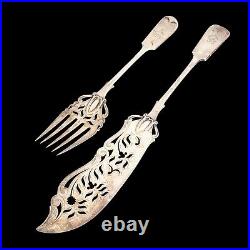
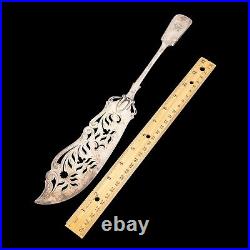
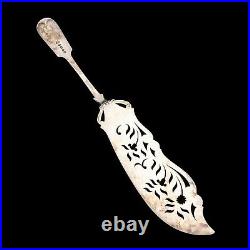
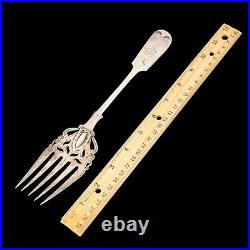
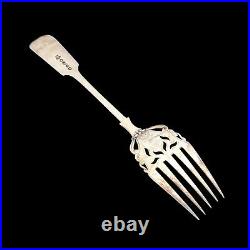

We have similar Fork, Knife, and Victorian items, which would pair nicely with this piece, for sale this week. Item Description by: Cait P. Markings: “E & Co” and “M” in diamond cartouche for the year 1851 on the back of the handles, Tested, and Guaranteed. Country of Origin: United Kingdom. Brand: Elkington & CO. Gram Weight: 308.4 Grams. 925 Sterling Silver Plated over Base Metal. Main Stone Measurements/Color. Accent Stone Measurements/Color. Item Measurements: The knife measures 14″ in length and 2.25″ at its widest. The fork measures 10″ in length and 2.05″ at its widest. Collectible Type: Fish Fork & Knife Serving Set. Men’s or Women’s: Unisex. Notable Features: This silverware set was handmade during the Victorian era. 925 sterling silver plated over base metal, the silverware set features. A knife and fork used for serving fish and accented with chased patterns in the Rococo style. The Rococo style emerged from the French royal court during the 1730s boasting whimsical designs of curling lines and curved edges, which would go on to spread throughout Europe and North America, remaining popular for centuries to follow. The large size of the fork and knife in this set indicates that they were used for serving fish and would have been available to only the most wealthy, who could afford the costs associated with such high quality silverware and to have many different sets of silverware for different purposes. As indicated by the markings on the hand, the set was made by Elkington & Co in Birmingham, England in 1851. Elkington & Co was. A flatware company known for their innovative silver plating techniques, which they used to not only create flatware and decorative items, but also jewelry and cutlery. The fork and knife both feature elegant designs of curling lines and leaf like patterns, which would have been very fashionable during this time period. Additional floral motifs adorn the fork. The knife does not have a serrated edge, as one might expect, due to its use in pulling apart and serving fish, making a sharp edge unnecessary. Instead the edge of the knife was designed with and asymmetrical curved edge. There is a monogram on the handle of both the knife and fork of what appears to be the initials “CA”. These letters were chased by hand during the Art Nouveau era, as the style the lettering indicates, suggesting the set was passed down through a family who had them monogrammed at a later date, most likely circa 1900. An incredibly well-preserved piece of family history from the Victorian era, this fish serving silverware set would make a valuable addition to any antique jewelry collection. Don’t miss your chance to preserve this piece of cultural history. Damage: Age appropriate wear. Tarnish on the sterling silver gives this piece an antique quality which we believe is quite lovely. This listing is for the item only. The Victorian era took place from the year 1836 to the year 1901, which was the span of Queen Victoria’s reign. Queen Victoria’s style was undoubtedly influential on the fashions of her country and ultimately led to three distinct jewelry trends emerging from the era. The first of these three styles was the Romantic period. The Romantic period was impacted by the Georgian period, which preceded it. The second period was the Grand period, which was primarily defined by mourning jewelry and the trends surrounding it. The final period was the Aesthetic period. The Aesthetic period was more lighthearted and airy than the previous periods and focused on aesthetic beauty and joy. This era features floral, natural, and feminine motifs, and utilized chased gold designs, enamel, and seed pearls. The late Baroque or Rococo period prevailed in the 18th century. The period was known for its substantial use of asymmetrical designs, curves, gold, and witty, whimsical themes. Both men and women at court wore sparkling gemstones set in gold during this period, as well as colorless glass pastes and pearls. Colored gems were often highly foiled behind them to enhance the depth of color. Jewelry was often created with naturalistic, floral designs. Rococo jewelry also featured embossed and engraved floral and feather designs on metal. Chasing is a metalworking technique that uses a nail-like tool and hammer to hand etch patterns onto a metal surface. This process creates a design that is sunk into the front of the surface using indentations, grooves, and channels. Chasing is thousands of years old and was a very difficult and time-consuming technique that is still used by metalsmiths today. This item is in the category “Antiques\Silver\Silverplate\Flatware & Silverware”. The seller is “abeautifultimeco” and is located in this country: US. This item can be shipped worldwide.
- Style: Victorian
- Age: 1850-1899
- Brand: Elkington & Co
- Type: Flatware – Sets
- Featured Refinements: Vintage Silverplate Flatware
- Composition: Silverplate
- Country of Origin: United Kingdom

